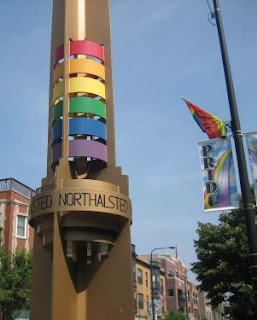Chicago is a large city, no doubt. But I've heard what makes Chicago most enjoyable are the small, village-like communities that link together to form a greater city. I want to talk a little bit about a neighborhood in Chicago called Boystown. As you could probably guess from the title as well as the conversations we've been having in class that this area of Chicago is known for its gay population. At its entrances, pillars with rings of the pride colors welcome visitors. Here you'll find vegan restaurants across the street from sex shops, and everything in between. There's a hopping nightlife, primarily for gays but one that is open for anyone to join. There's plenty of signs advertising "underwear parties" on the sides of buildings on the way to the Red Line. A lot of this sounds similar to Gay New York. In the section I have to read for Wednesday Chauncey mentions the cafeterias. Here gays would hang out, and "let their hair down." The bars and restaurant of Boystown mirror this. That is, until harsher laws against "degenerates" fought to remove all gay activity from these locations. Of course with some bribing and good connections, the theatrics continued.
Boystown also houses some organizations that wouldn't have been found the New York Chauncey displays. Organizations like the Center on Halsted house youth and promote gay culture, all the while screening for HIV tests and fighting for gay rights. The Marin Foundation seeks to build bridges between the gay community and evangelical Christians. These and a slew of other organizations seek to integrate the gay community into the greater Chicago area and the nation beyond. As we mentioned in conversation today, that didn't occur in turn of the century New York. There, it was all for show amongst that community. Now, Boystown invites all people in to experience the life of a homosexual.

Enich,
ReplyDeleteThanks for this information that extends our study across time and space. It gives a small response to Liza's question about how representative Chauncey's study is. Of course that is always a question about case studies: how representative are they? What generalizations can be made from them?
LDL
After reading your post I wondered if I could find such communities in Beijing since it is a humongous city and there should be an area like boystown. But there aren't any!! I was disappointed!Remember that article we read in soc about gays in china? I think change won't happen fast. We can't yet start talking about gay rights in China because if the Chinese push for this too fast then we will just get the opposite.
ReplyDeleteI think part of that probably comes from the cultural differences of our two countries. There was a line in that article that said even if gays were to openly display themselves as such, there is an understanding that even if someone dissaproves, they won't be vocal about it. In America it is all about freedom, so it only makes sense to gather in communities where you can be yourself. Chinese culture is different in that respect.
ReplyDeleteBut of course, I must acknowledge DeAne that case studies are generalized. There are, of course, extremes that occur outside of its conclusions. And every case will be different, for sure.